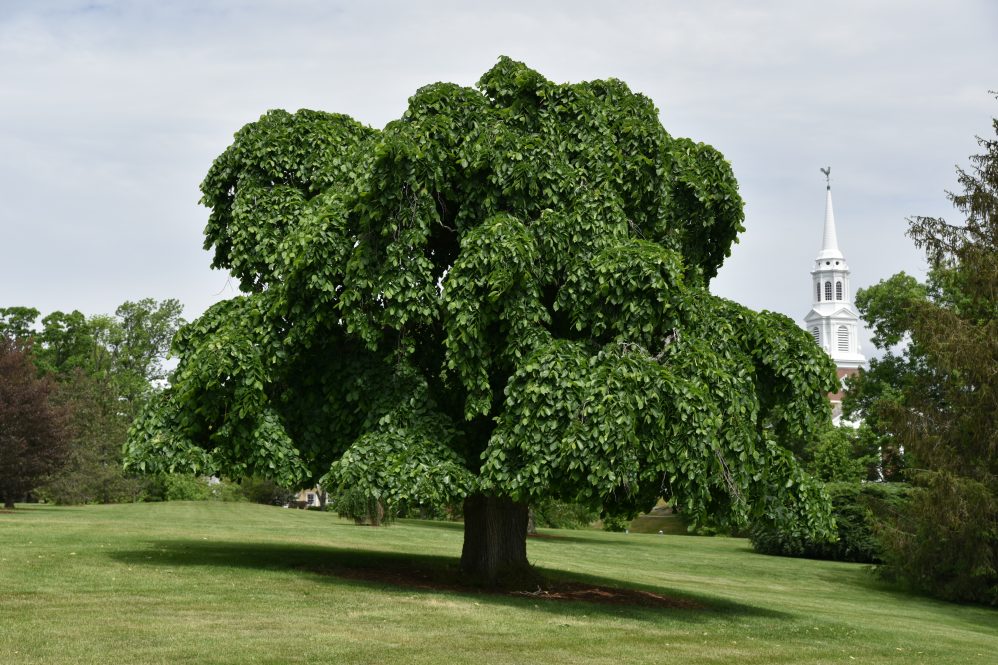About 130 years have passed since Alfred G. Gulley, a horticulture professor at what was then Connecticut Agricultural College, started planting ornamental trees on its Great Lawn for education and beautification.
Thanks to Gulley’s foresight and others who’ve carried on his legacy since then, the diversity and beauty of the 5,000-plus trees now growing throughout UConn Storrs recently earned certification for the campus as a Level II Arboretum.
The prestigious status is bestowed through a national accreditation program assessing the variety and number of trees at a site, conservation efforts, public engagement, and other attributes that demonstrate a commitment to a thriving natural environment.
Earning the accreditation also underscores UConn’s stewardship of its environmental resources and the inextricable link between the wellness of the campus and that of those who learn, work, and visit there – all of which are among the many elements emphasized in UConn’s 10-year Strategic Plan.
The Storrs campus is a living laboratory where people can enjoy and learn from nature, and can become part of the University’s history by participating in tree-plantings, Earth Day Spring Fling events, tree tours, and other activities.
In fact, the guided and self-guided tree tours include stops at some of the trees that remain from Gulley’s time on campus, including the oldest: a Camperdown Elm planted in 1895 and still standing on the northwest corner of the Great Lawn.
“The landscaping at UConn, particularly the trees and shrubs, are notable features contributing a great deal to the uniqueness of our campus. This diverse collection of woody plants is important in teaching as well as being a handsome addition to campus,” says Gregory Anderson, a Board of Trustees Distinguished Professor Emeritus of ecology and evolutionary biology.
Anderson is also co-chair of the UConn Arboretum Committee, which spearheaded the accreditation application process and manages the tree inventory on campus. The committee comprises faculty, staff, UConn retirees, and others who team with University Planning, Design, and Construction (UPDC); the Office of Sustainability; Facilities Operations; and other individuals and departments.
The committee and its partners received word recently that the University’s application for Level II Arboretum Accreditation had been approved by The Morton Arboretum, which administers the ArbNet Arboretum Accreditation Program.
To achieve Level II status, UConn had to show it has more than 100 species on campus. That was easy: It has more than 425 species with more than 90 unique genera, including various kinds of maples, oaks, birch, pine, and others.
It also had to show that the University maintains a current, reliable inventory of the collections; has at least one person responsible for it as part of their job; and offers enhanced educational and public programming.
In fact, most of the trees in UConn’s core campus are identified and tagged with a unique number linked to a GIS database, providing information that the public can view about each tree’s species, the planting date if known, and other details.
“It is a special honor to be a steward of our campus landscapes and a distinct pleasure to be in a role that presents such unique opportunities to advocate, prioritize, and help administer various activities that support our beloved arboretum in Storrs,” says Sean Vasington ’99 (CAHNR), University Landscape Architect and Director of Site Planning for UPDC.
“This accreditation was only possible with support from our Provost and other leadership, our Arboretum Committee chairpersons and its members, our tree warden, our arborists, and several others whose collective efforts helped realize a shared vision,” he adds. “The recognition is well-deserved and long overdue, and UConn now stands united with over 700 other accredited arboreta from at least 40 different countries around the world.”
The accreditation also comes as UConn celebrates its 11th year designated as a “Tree Campus USA” from the Arbor Day Foundation.
The UConn Arboretum Committee was established in the mid-1980s by Anderson and the late David Schroeder, Professor Emeritus and former head of the Department of Natural Resources Management.
The committee and its members are the latest in a long line of people and groups to have embraced Gulley’s vision in the 130 years since he started planting trees on the Great Lawn.
Among the most notable people to advance the work on campus were UConn professors Kenneth Bradley (1914-2003), who spent decades procuring rare trees from sources worldwide to plant on campus to add diversity and beauty; and Sidney Waxman (1923-2005), who developed more than 40 different cultivars of dwarf pines during his career that became popular landscape elements in suburban lawns worldwide.
In fact, those dwarf pines were among the many species that UConn could reference in its application for arboretum accreditation.
The campus also includes more than 160 trees of special interest, and are considered notable either because they are memorial trees; species that aren’t common in the region; state champion trees due to their size or other attributes; “class trees” planted by members of graduating classes, or trees on UConn’s self-guided tree walk.
“The Arboretum is a living laboratory supporting the academic mission and strategic vision of our top research university,” the accreditation application reads. “It is an asset of great beauty and scientific interest to the University community, the citizens of Connecticut, and to all visitors of our quintessential New England college campus.”
—
Annual class tree plantings and other activities associated with the UConn Arboretum are supported by philanthropy, in-kind services, and volunteer efforts. To donate, please consider a gift to the Campus Beautification Fund.



